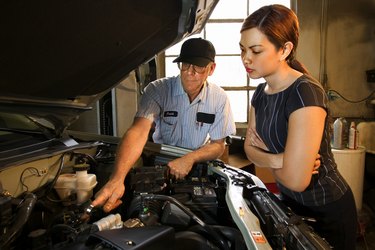
Devices that measure the relative pressure of a vacuum use approaches ranging from mechanical deflection to the measurement of weak electrical currents caused by ionized gas molecules. Different types of gauges measure different ranges of pressure. As pressure drops to near perfect vacuum, more sensitive gauges measure smaller changes. The most common vacuum gauge in the home workshop measures changes in engine manifold air pressure as pistons draw air into combustion chambers.
Mechanical Gauges
Video of the Day
One approach to vacuum measurement uses a curved metal tube connected to the vacuum source. As pressure in the tube drops, the tip bends and moves a hairspring. The change in hairspring tension shifts a needle along the face of a calibrated dial. Other mechanical gauges use a sealed air chamber separated from the vacuum source by a diaphragm. As pressure drops, the diaphragm expands. A mechanical system converts the movement of the diaphragm to a dial reading. Mechanical vacuum gauges can also connect dial displays to sealed capsules that expand when pressure in the surrounding chamber falls.
Video of the Day
Electrical Gauges
Using the same system of sealed chamber and moving diaphragm, electrical gauges convert the diaphragm movement to changes in capacitance or inductance, displayed on either analog or digital readouts. An electrical plate attached to the diaphragm and positioned parallel to a fixed plate forms a simple capacitor that stores an electrical charge in the open space between. As changes in air pressure move the diaphragm's plate, capacitance changes. Coils arranged in a similar way change in inductance as the distance between them changes, resulting in a readable voltage difference. Calibration requires comparison to a gauge already known to be accurate.
Thermal and Ion Gauges
Thermal gauges or ion gauges measure the smallest pressure changes in the lowest of vacuums. Thermal gauges detect changes in a gas's ability to dissipate heat. As pressure falls, gas conducts heat less efficiently. As a copper wire heats, its electrical resistance rises, so changes in resistance when the power input stays constant reveal subtle changes in air pressure. Ion detectors measure even smaller pressures, using charged plates to bounce electrons through the vacuum. Any remaining gas molecules struck by the electrons develop an electrical charge and flow to an ion collector plate, causing a measurable electrical current that changes as the number of available gas molecules falls.
Automotive Vacuum Gauges
A carburetor's throttle plate restricts the amount of air that mixes with the engine's fuel. This causes low pressure between the throttle plate and the valves that let air into piston chambers. Automotive vacuum gauges connected to the manifold read the vacuum in inches of mercury, a measurement of atmospheric pressure. Vacuum below 3 inches during starting means poor compression and possible worn piston rings. Fluctuating vacuum pressure while idling could mean leaking valves in one or more cylinders. Steady vacuum indicates all cylinders firing with equal power. The extra friction of long vacuum gauge hoses damps out subtle pressure shifts. Cracked or crimped hoses also cause false readings.